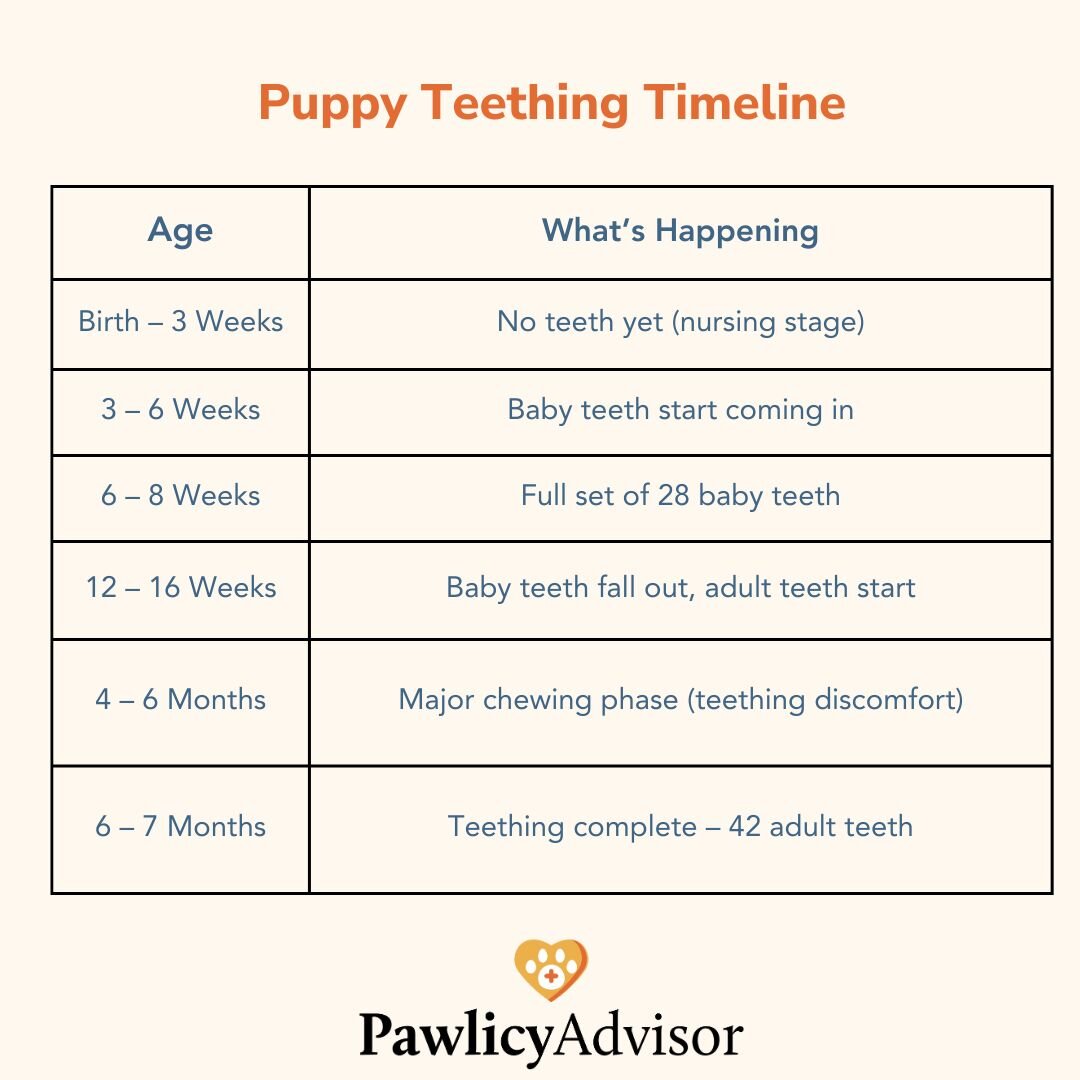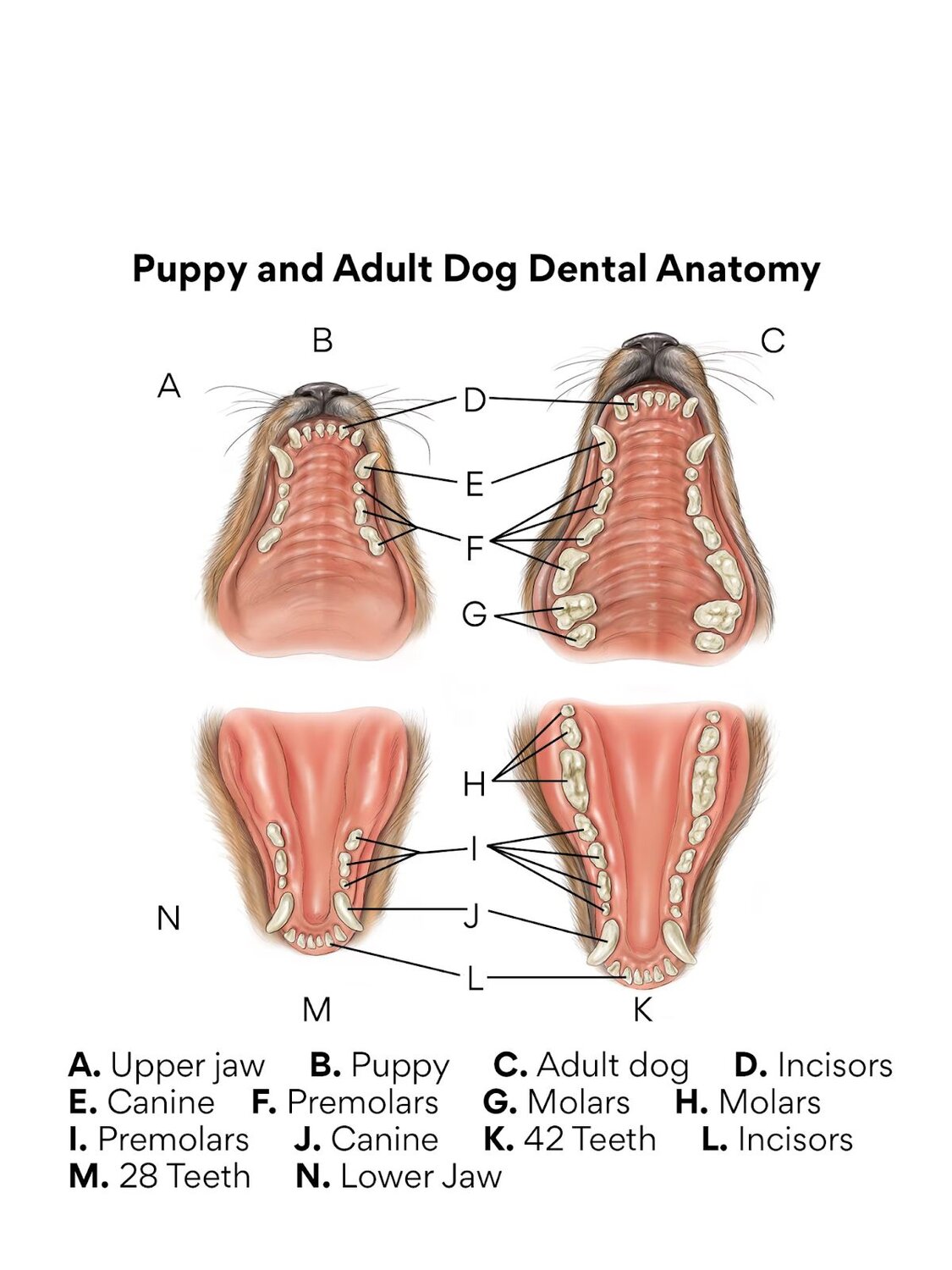The Ultimate Puppy Teething Survival Guide
Bringing home a furry addition to your family is an exciting time full of learning and growth. Among the key phases of raising a puppy is teething, the period in a young dog's development that marks the transition from baby to adult teeth.
During this time, you may notice your puppy exhibiting teething behaviors, such as excessive chewing and biting, or noticeable discomfort.
While this stage can be frustrating, understanding the teething process and knowing how to ease your puppy’s pain can make a world of difference.
Key takeaways
- Puppy teething lasts from around 3 weeks to 6 months of age.
- Common teething signs include excessive chewing, drooling, and gum sensitivity.
- Chew toys and frozen treats can help your puppy manage teething pain, while training techniques can help curb inappropriate chewing.
- Avoid using punishment or letting your puppy chew harmful items or hard bones.
- Visit the vet if you notice retained baby teeth, excessive bleeding, or extreme discomfort.
Looking to save on vet bills? See if pet insurance is right for you.
Instant results. No spam. 1M+ pet parents served.
In this guide, we’ll explore everything you need to know about puppy teething, from recognizing the signs and offering the best solutions to knowing when veterinary intervention might be necessary.
By the end, you'll have practical, vet-approved strategies to help your pup navigate this milestone safely and comfortably.
✔️ Reviewed by multiple licensed veterinarians
✔️ Updated with the latest medical data
✔️ Compiled from veterinary research
Understanding puppy teething
When do puppies start and stop teething?
Puppies start teething at around 3 weeks of age, when their baby teeth emerge. By 6 to 8 weeks old, they should have a full set of 28 baby teeth.
The real challenge begins around 12 to 16 weeks, when puppies start losing their baby teeth to make way for their 42 adult teeth. This process is usually complete by 6 months of age. However, some puppies may experience delays or complications that require veterinary attention.
Signs your puppy is teething
Identifying the signs of teething can help you take proactive measures to manage your puppy’s discomfort. Common indicators include:
- Excessive chewing on toys, furniture, shoes, and hands
- Increased drooling
- Swollen or red gums
- Mild bleeding from the gums
- Whining or irritability
- Decreased appetite due to gum sensitivity

Best puppy teething solutions
Chew toys for teething puppies
Providing appropriate chew toys is one of the best ways to soothe a teething puppy. When evaluating chews, look for:
- Rubber toys are durable and gentle on sore gums.
- Frozen treats, such as chilled rubber toys or frozen carrots, can provide cooling relief.
- Rope toys encourage chewing while being soft enough for sensitive gums.
Safety considerations: Always choose non-toxic, vet-approved materials and avoid toys that can break into small, easy-to-swallow pieces.
Home remedies for puppy teething pain
If you prefer a natural approach, try these home remedies:
- Frozen carrots are a nutritious and cooling treat.
- Damp frozen washcloths are soft enough to chew while providing soothing relief.
- Ice cubes can help numb pain, but you should offer them only under supervision.
While many puppy owners focus on offering relief through chew toys and treats, it's also essential to remember that teething is a vital time in your puppy's development. Providing not only comfort, but also opportunities for learning good habits and behavior can help shape your dog's emotional and mental well-being long after the teething phase ends.
Dr. Angela Beal DVM, FFCP
Training techniques to curb destructive chewing
Redirecting chewing behavior helps prevent damage to household items. Consider these techniques:
- Use positive reinforcement: Praise and reward your puppy when they chew on appropriate items.
- Redirect their focus: When your puppy chews something they shouldn't, swap it out with an acceptable chew toy.
- Supervise playtime: Monitor playtime to ensure your puppy develops safe and constructive chewing habits.
What to avoid when helping a teething puppy
Avoid these common mistakes while helping your puppy through teething:
- Allowing access to harmful items: Keep electrical cords, toxic plants, and small objects out of reach.
- Scolding or punishing: Harsh punishments can scare or confuse your puppy. Focus on redirection instead.
- Giving hard bones: Puppies’ developing teeth are fragile, and hard bones can cause fractures.

Source: PetMD
When to see a vet
Teething is a natural process that does not require intervention in most cases. However, some situations may warrant professional attention. Consult a vet if you notice:
- Retained baby teeth that don’t fall out on schedule
- Excessive bleeding from the gums
- Extreme discomfort that affects eating and drinking
- Swollen or infected gums
Professional solutions: Your vet may recommend a dental check-up, safe pain relief options, or, in some cases, the extraction of stubborn baby teeth.
Teething is an essential developmental stage, but it can sometimes lead to unexpected health concerns. Investing in pet insurance early ensures you’re covered for potential dental issues or emergency visits. Explore Pawlicy Advisor to find the best plan for your puppy today.
Setting your puppy up for success
Helping your puppy through the teething stage requires patience, consistency, and the right resources. Providing safe chew toys, using effective home remedies, and reinforcing positive behaviors can help you make this developmental phase smoother for you and your furry friend.
Every puppy is different, so be attentive to their needs and adjust your approach as necessary. If you notice prolonged discomfort or abnormal teething patterns, don’t hesitate to consult your veterinarian.
As a responsible pet owner, planning ahead is just as important as addressing current challenges. Pet insurance can protect you against unexpected veterinary expenses and set your puppy up for a lifetime of health and happiness. Explore your options with Pawlicy Advisor today and give your puppy the best start possible.
Your new puppy may be small — but their vet bills won't be.
Save big on costs with pet insurance, so you can protect your puppy while protecting your wallet.
Frequently asked questions about puppy teething
What are the best teething solutions for puppies?
The best teething solutions for puppies include appropriate chew toys (e.g., rubber toys, frozen treats, rope toys), home remedies (e.g., frozen carrots, damp frozen washcloths), and targeted training techniques (e.g., positive reinforcement, redirecting chewing behavior).
When do puppies start teething, and how long does it last?
Puppies typically start teething around 3 weeks of age when their baby teeth emerge. The most noticeable teething phase occurs between 12 and 16 weeks, when they begin losing their baby teeth to make room for adult teeth. This process is generally complete by 6 months of age.
How can I stop my puppy from chewing on everything?
To stop your puppy from chewing on furniture or other items, provide them with appropriate chew toys and use redirection techniques. When they chew something they shouldn’t, calmly replace it with a safe chew toy and reward them for chewing the correct item.
Is it safe to give my puppy frozen treats for teething?
Frozen treats can be very soothing for teething puppies. Chewing on frozen carrots or a damp washcloth offers cooling relief, and chilled rubber toys help numb sore gums. Always supervise your puppy when using these remedies to ensure they don't swallow large pieces.
Can teething cause a puppy to lose their appetite?
Teething can cause a decrease in appetite due to gum sensitivity. Puppies may experience swollen or red gums that make chewing painful. Offering softer food and home remedies like frozen treats can help alleviate the discomfort.
What should I avoid giving my teething puppy?
Avoid giving your puppy hard bones, which can cause tooth fractures, and steer clear of harmful household items like electrical cords or small objects that pose a choking hazard. Never scold or punish your puppy for chewing, which can lead to confusion and fear.
How do I know if my puppy's teething is causing severe pain?
Puppies experiencing severe oral pain may exhibit excessive drooling, an inability to eat or drink, or extreme irritability. If these symptoms persist, consult a vet to rule out complications like retained baby teeth or infected gums.
Do I need to take my puppy to the vet for teething?
While teething is a natural process that does not usually warrant intervention, you should consult a vet if you notice retained baby teeth, excessive bleeding from the gums, or extreme discomfort affecting eating and drinking habits. A vet may recommend pain relief or, in some cases, dental treatment.
How can pet insurance help with puppy teething?
Pet insurance can help cover the cost of unexpected dental issues or veterinary visits related to teething complications. Invest in pet insurance early in your puppy’s life to ensure they’re covered for potential dental problems and emergency care.
Do you want to find the best pet insurance?
Let's analyze your pet's breed, age, and location to find the right coverage and the best savings. Ready?
Analyze My PetAbout Pawlicy Advisor
The pet insurance marketplace endorsed by veterinarians, at Pawlicy Advisor we make buying the best pet insurance easier. By comparing personalized coverage and pricing differences we can save you a ton of money, up to 83% in some instances!
Instantly Compare Pet Insurance Plans
Guides
Determine If Pet Insurance Is Worth It
Comparison Charts
Find Your State
Dog Insurance
DVM, FFCP
Dr. Angela Beal has worked in private practice and taught veterinary technicians for 15 years. Angela is a veterinarian who loves using her writing to help pet owners provide the best possible care for their furry companions. Since 2020, she has worked full-time within the veterinary education writing and editing industry. Angela lives in Columbus, Ohio with her husband, two sons, and their spoiled Chihuahua mix, Yogi.
